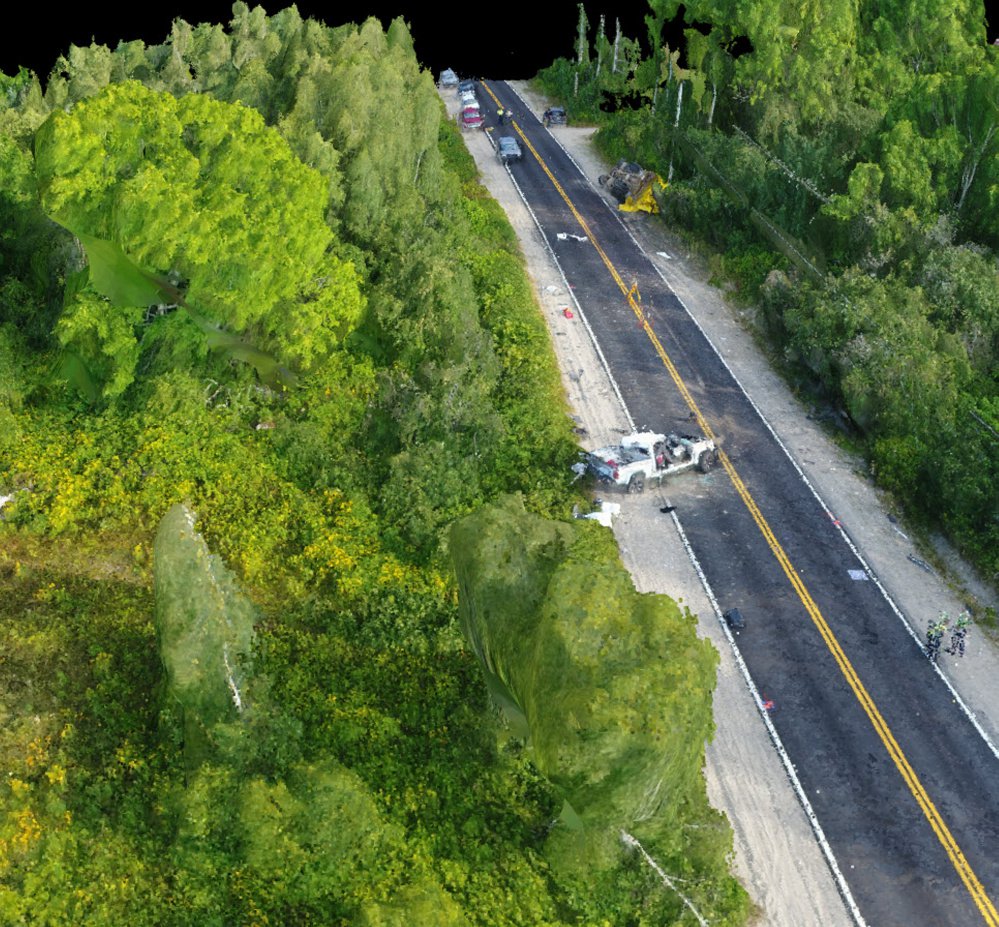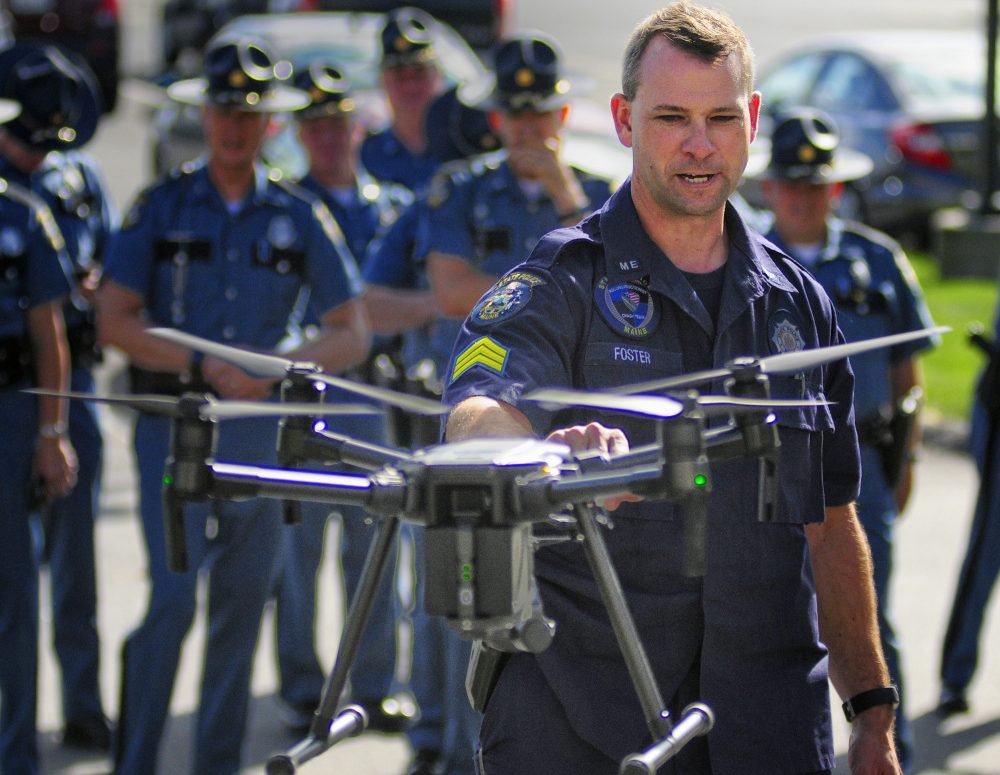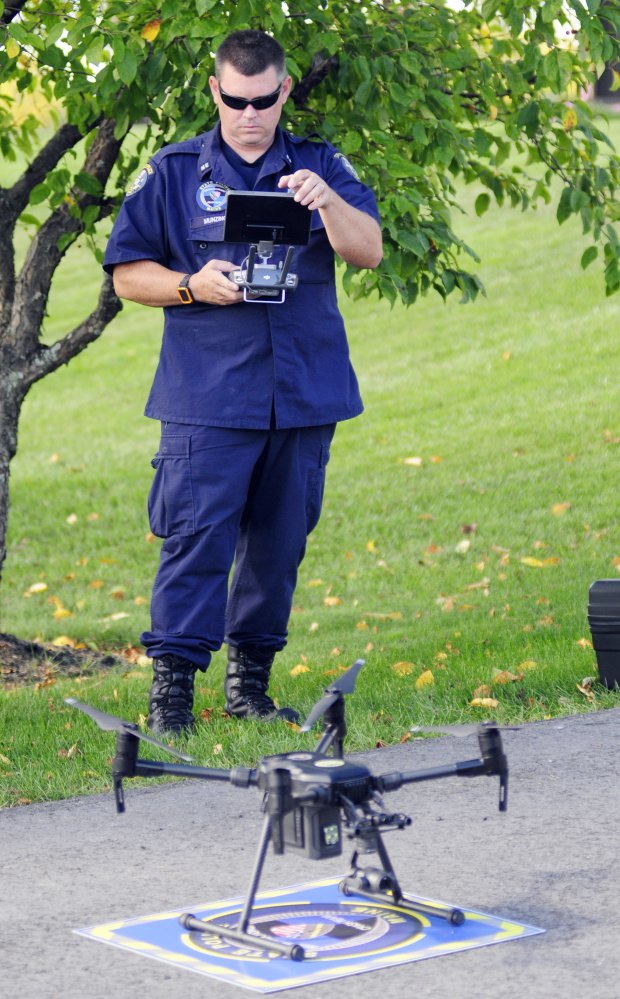AUGUSTA — In the past, when two or more vehicles collided in a remote part of the state, it might have taken Maine State Police more than 24 hours to travel to the scene, photograph the wreckage and process the images to help determine what caused the crash.
But in early August, when a pickup truck crashed into a blueberry truck in Northfield, it took the agency far less time. Its investigators recently started using cameras mounted on remote-controlled drones to snap photos of crash scenes, along with software that stitches the digital images together.
After the Northfield crash, investigators “took 81 pictures, and it took 14 minutes, and they’re done,” said state police Col. Robert Williams. Without a drone, he said, “that would have taken at least two hours at the scene and 30 hours back at the office.”
Williams spoke Thursday outside state police headquarters as three drones, or unmanned aerial vehicles, flew overhead. For the last two months, state police have used the flying, camera-mounted machines to document crash scenes, and supervisors from around the state were in Augusta to learn more about the technology.
“It’s just a way to bring a new technology to something that we have done for years,” Williams said. “It’s no different than black-and-white photos becoming colored. This is just a new way to take photos.”
Given how much more efficiently drones can capture images over a large area, the new technology has raised alarm among some citizens and groups such as the American Civil Liberties Union of Maine, which says it could violate the privacy of Maine residents if appropriate protections aren’t in place.
In 2015, those groups helped get a law passed that regulates the use of drones by Maine police.
The law prohibits the use of drones in criminal investigations when a warrant hasn’t been obtained, but allows them to be used to photograph crash scenes. It also directed the Maine Criminal Justice Academy to establish minimum standards for any police agency that uses drones, including training requirements for operators and restrictions on the use of high-powered lenses and facial recognition technology.
Drones are still a rare technology among Maine’s law enforcement community. As of the summer of 2016, no police agencies in the state reported using drones as part of their investigative work, according to an annual report that the Maine Department of Public Safety must file with the Legislature. And state police Lt. Bruce Scott said he is unaware of any other police agency using drones in the state.
State police have used drones to take pictures at 18 crash scenes so far, said Scott, who commands the agency’s traffic safety unit. One of those uses occurred Wednesday morning, when a fatal motorcycle crash closed an on-ramp to Interstate 95 in Augusta, he said.
The state’s overall highway death toll this year is 124, up 17 percent from the 105 reported during the same period in 2016.
Three members of Scott’s unit have been licensed by the Federal Aviation Administration to fly drones, and they also have performed about 35 training flights, he said.
State police have bought three DJI Matrice 200 drones, each costing about $5,000.
To use them, the agency’s licensed pilots, who all have worked as crash investigators, must drive to the accident scene and assemble the machines. With a remote control, they can direct the drones and see what’s on-camera using a small attached monitor. The devices also include safety features, such as transceivers that alert the operators when airplanes are nearby and sensors that are supposed to prevent drones from colliding with other objects.
At this point, Scott said, the agency is using the technology “to augment” its crash investigations, but he said that other opportunities could arise for the agency to use drones, as long as they’re legal.
He also dismissed the privacy concerns around drone use. State police follow the rules that were included in the 2015 law regulating drone use, he said. And when a vehicle unrelated to a crash investigation is caught on a drone’s camera, he said, the drone operators can remove that person from the final rendering of the photo that’s submitted to investigators.
“We just delete the vehicles out of the pictures,” Scott said. “As you do your rendering, you remove everything other than what’s pertinent to your scene. … We haven’t had any issues or concerns with privacy violations, and I don’t anticipate those being a problem.”
Oamshri Amarasingham, advocacy director at the ACLU of Maine, questioned how practical it can be for the state police to crop unrelated individuals out of every photo taken at an accident scene.
There are appropriate situations for first responders to use drones, such as when firefighters used them at the scene of a Sanford apartment fire in June, Amarasingham said.
But Amarasingham, who helped get the 2015 law passed in Maine, also questioned what level of privacy protections the state police have included in their internal drone policy.
Scott and Maj. Christopher Grotton, who oversees the agency’s drone usage, did not respond to requests Thursday for a copy of the agency’s drone policy.
Earlier in the day, Williams said the agency based its program “word for word” on Maine’s statutes and the guidelines set by the Maine Criminal Justice Academy. State police also follow rules set forth by the FAA, he said.
Charles Eichacker can be contacted at 621-5642 or at:
ceichacker@centralmaine.com
Twitter: @ceichacker
Send questions/comments to the editors.





